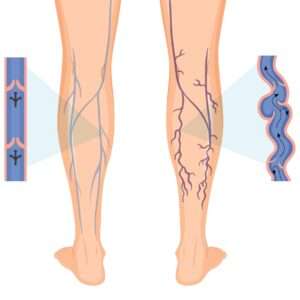YOUR CART
- No products in the cart.
Subtotal:
₹0.00
BEST SELLING PRODUCTS

Varicose veins are enlarged and twisted blood vessels, often appearing dark blue and prominently raised on the skin’s surface, resembling raised tunnels. Typically manifesting in the legs and ankles, varicose veins are a common vascular condition.
The human leg comprises two primary vein systems:
1. Deep Veins: These are responsible for transporting most of the blood from the legs back to the heart.
2. Superficial Veins: Located just beneath the skin, these veins can become varicose. They contain one-way valves to ensure blood flow towards the heart. However, when these valves fail, blood flows backward, exerting excessive pressure on the veins, leading to varicose veins.

Spider or varicose veins can affect anyone, but they are more prevalent in women, with females being twice as likely to develop them as males. Individuals in professions requiring prolonged standing, such as nurses, teachers, and traffic police officers, are also at higher risk. Other contributing factors include aging, obesity, pregnancy, prior leg trauma or surgery, and genetic predisposition. Typically, these veins are most noticeable in the thighs, legs, and feet.
Yamuna Pharmacy offers the Garli-Zn-Co capsule, an ayurvedic formulation designed to restore normal elasticity to the blood vessels, nerves, arteries, veins, and muscular tissues. This remedy blends minerals, herbs, and herbal extracts, adhering to traditional Ayurvedic principles.
The propensity for varicose veins is often hereditary, with women being more vulnerable, especially due to hormonal changes, pregnancy, contraceptive use, menopause, and hormone replacement therapy.
Pregnancy, particularly in the first trimester, can exacerbate varicose veins due to elevated hormone levels and increased blood volume, as well as pressure exerted by the growing uterus. While the condition often improves within 3-4 months post-pregnancy, successive pregnancies might lead to the persistence of these abnormal veins.
1. Pregnancy – particularly in the first trimester, can exacerbate varicose veins due to elevated hormone levels and increased blood volume, as well as pressure exerted by the growing uterus. While the condition often improves within 3-4 months post-pregnancy, successive pregnancies might lead to the persistence of these abnormal veins.